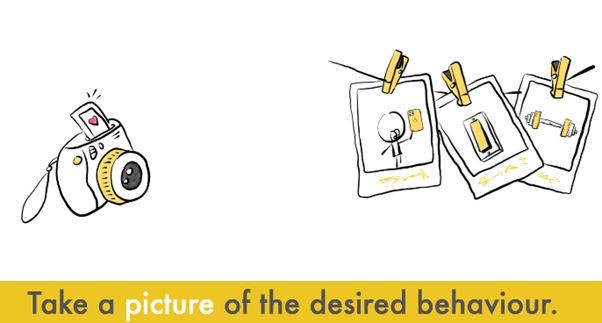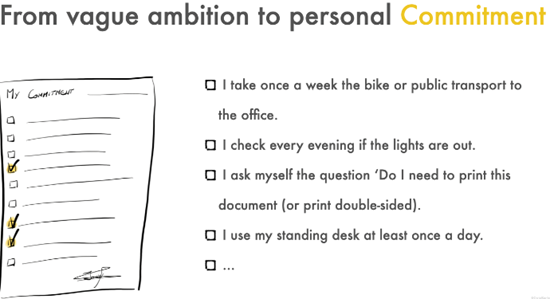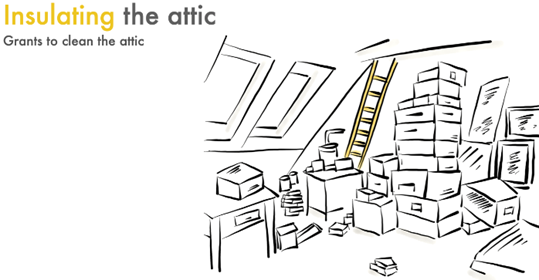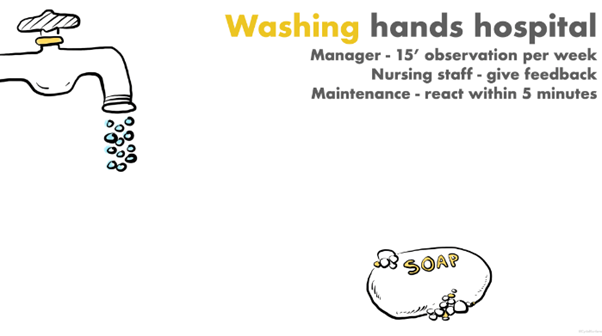13.03.2025
The Brainfix Series 5 - Make it Specific - And take a picture

Welcome to episode five of my Brainflix-series! Ready to make it… specific?!
Many organisations have high ambitions, but formulating clear objectives often remains a challenge. They aim for sustainability, customer-centricity, or innovation without making these goals tangible. This vagueness can be paralysing for employees like our good old Nic, who don't know where to start and end up sticking to old behaviours. But there's a solution.
A practical way to kickstart change is by asking yourself: Can I make a picture of the desired behaviour? If the answer is yes, it suggests that the change goal is clear enough.
For instance, if your organisation aims to prioritise sustainability, outlining specific actions is crucial. Simply expressing a desire for sustainability lacks clarity. Detailing actions like "reducing energy consumption" remains vague.
However, setting a clear expectation, such as "every employee turning off lights & computers in the evening," can be easily imagined, enhancing clarity and facilitating implementation.

🎯 From Goals to Actions: Personalizing Change for Impact 🚀
To truly effect change, it's crucial to translate these grand goals into specific actions at various levels within the organisation. Departments can identify their own contributions that align with their expertise and capabilities. For example, the accounting department may focus on reducing paper usage, while the sales team may choose to conduct more virtual meetings rather than spending an hour driving to attend in-person meetings. By pinpointing these specific actions, employees know exactly what is expected of them, thereby increasing the likelihood of success.
But let's delve even deeper. What if we were to translate big goals, such as sustainability or customer focus, down to the personal level? Could we create a personalised commitment list? How would this work in practice?
Imagine compiling a list of 10 to 15 highly specific actions individuals can take to promote sustainability. These actions could include commitments like biking to work once a week, opting for public transportation, ensuring lights are turned off in the evening, or considering double-sided printing before hitting "print" on a document.
The key is to make these actions tangible and manageable, so they become part of daily routines. Once the list is created, individuals can be asked to select a subset, say 3 to 5 actions, that resonate most with them. By actively choosing their commitments, individuals are more likely to follow through because they've made a personal investment in the process.
This approach not only translates vague goals into concrete actions, but also increases the likelihood of behavioural change. In essence, by encouraging personalised commitments, organisations can bridge the gap between overarching goals and individual behaviours, ultimately driving meaningful change from within.

🏠 Attic Tales: The Curious Case of Clutter and Insulation 🕵️♂️
It's essential not only to be precise in our actions but also in our analysis of situations. Sometimes, we quickly decide to go in a certain direction without really checking if we're working on the right problem.
The importance of thorough analysis is often overlooked. A situation that perfectly illustrates this, occurred in the United Kingdom. There, efforts were made to encourage homeowners to insulate their attics. Despite subsidies being provided and the environmental benefits being emphasised, the desired behaviour did not materialise.
The intriguing aspect was that the initiatives did not yield the desired results, even though the benefits seemed obvious. However, then the "Nudge unit" stepped in. This specialised unit decided to thoroughly analyse the problem by engaging in conversations with the stakeholders.
What they found was surprising: people were indeed aware of the benefits of insulating their attic, but it wasn't the financial savings or the environmental aspect that deterred them. It was the clutter in their attic that they were reluctant to deal with.
Thanks to this in-depth analysis of the problem, new insights were gained. Instead of clinging to the assumption that cost savings and environmental friendliness would be sufficient to motivate people, they discovered the real barrier: the clutter.
In response, the initiatives were adjusted. Instead of offering subsidies for insulation, they offered subsidies to declutter attics. This turned out to be a resounding success. People were now motivated to take action.
By avoiding assumptions and identifying the real pain points, we can find more effective solutions and better achieve our goals.

🤲 The Art of Specificity: Elevating Hand Washing Protocols Across Roles 📈
In a hospital, hand washing by nursing staff is a crucial hygiene measure to keep diseases at bay. At first glance, this action may seem very specific, but when we look at different roles, it turns out that there can be even more specific tasks.
The nursing staff themselves can take specific actions by providing feedback to each other. If they notice a colleague forgetting to wash their hands, they can address this constructively and provide immediate feedback, without being accusatory.
For the manager, specific action, for example, may involve spending fifteen minutes weekly observing the nursing staff. This allows them to identify patterns, such as forgetfulness during emergencies, and learn from these observations.
For the maintenance staff, specific action may mean responding within five minutes to refill the soap dispenser if they receive a notification that it's empty. These are examples of how hand washing can be made even more specific across different job roles within an organisation.
This illustrates the importance of making actions specific, even for tasks that may seem very concrete at first glance. It shows how a small adjustment in tasks can make a difference in achieving organisational goals and ensuring quality and safety.

💭 Sssss ... A moment of reflection 🌟
How do you think you can apply the concepts of specificity and personalized commitments to enhance your change initiatives? Identify specific actions that align with your goals and drive meaningful change within your organization. Start small but think big, and watch the impact grow!
Cheers,
Nic (aka Cyriel)
====
Hi, I’m Cyriel - international speaker on 'Making Change Simple'
Change is constant and often scary, but it doesn’t have to be. I bring a simple perspective to help leaders and teams tackle change confidently. Through practical insights, interaction, and humor in my keynotes, you can turn the fear of change into opportunity.
Don’t mind the change. Change your mind.

